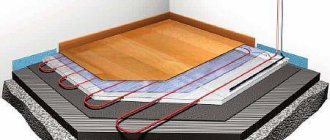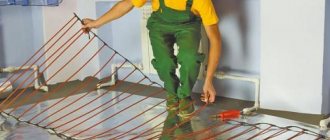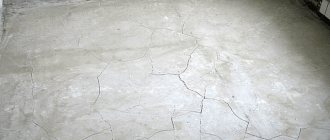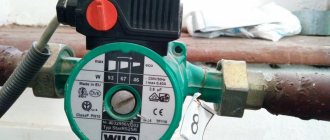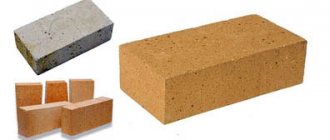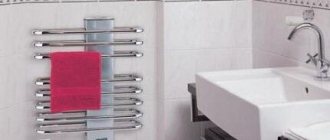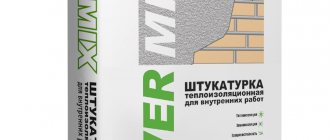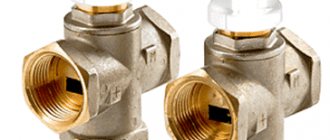Warm floors are of two types, depending on the heating method.
Selecting and laying the underlay under the heated floor
Mermen
Heating is carried out by a pipeline system, the coolant is hot water.
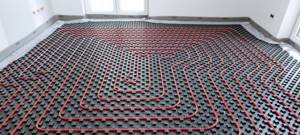
Water heated floor
They are used in most cases in private homes; when connecting hot water in multi-apartment buildings, big problems arise due to the disagreement of management companies to give permission to connect to common building heating networks for two reasons. Firstly, in this case it is difficult for them to control the specific consumption of thermal energy by each consumer individually. Secondly, boilers may not be able to withstand a significant increase in energy consumption.
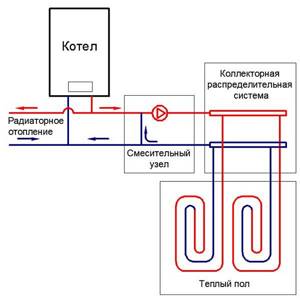
Water heated floor diagram
It is not always possible to install a separate heating boiler in city apartments, and such installation, together with the price of the equipment, is quite expensive.
Electrical
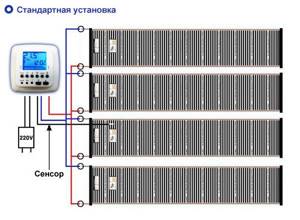
Standard electrical diagram for connecting an infrared film heated floor
The temperature rises due to the resistance of the current conductors. From school we know the formula Q (energy released) = I (current strength) × R (conductor resistance) .
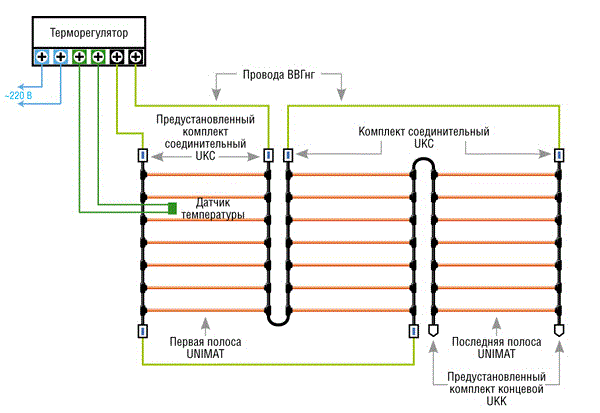
Connection diagram for cable heated floors
Depending on the physical characteristics of the conductors, heated floors can be film (infrared) or cable (conducting elements are ordinary flexible cables and improved insulation). Electric floors have their own difficulties; during their installation, it is necessary to take into account the parameters of the existing wiring and special protective fittings.

Infrared heated floor diagram
To effectively heat floors, the power per square meter must be at least 250 kW; in total, larger values are used.
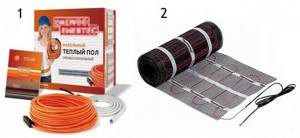
Types of electric heated floors: 1 - Cable. 2 — Cable with reinforcing mesh
Currently, manufacturers produce a wide range of substrates, differing in linear characteristics, materials of manufacture and the ability to perform additional functions.
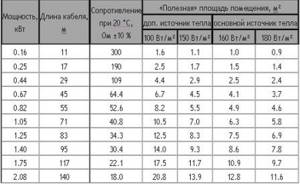
Power of electric heated floor
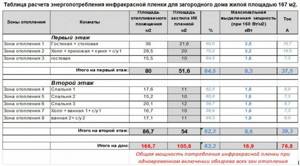
Electricity consumption of film heated floors
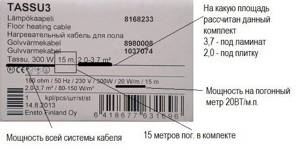
Warm floor marking
Advantages of heated floors
Perhaps the most important requirements that a person who wants to acquire a heated floor poses are:
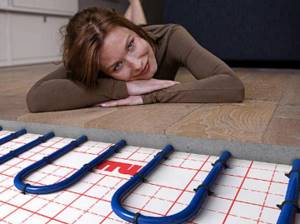
Environmental friendliness- Durability
- The optimum ratio of price and quality
- Easy to install
- Simplicity of design and maintenance
Water heated floors meet all these requirements. It does not emit any kind of radiation, except perhaps thermal radiation, it is economically justified and has a long service life.
Warm floors are unpretentious to use, and taking into account the durability of modern materials, they will serve the owners for a long time and effectively, creating a truly cozy, “warm” atmosphere in the house.
Characteristics of materials for substrate equipment
In some cases, homeowners try to use any materials that are on hand or that are low cost for thermal insulation.
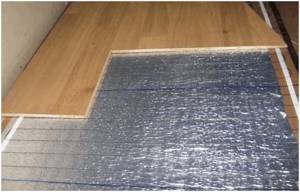
Let's consider the characteristics of a substrate made of various materials:
- Polyethylene foil, self-adhesive - thickness 8 mm. It is highly reflective, hydro and sound insulating.
- Single-sided polyethylene, laminated - thickness 8 mm. It has good thermal insulation and water resistance.
- Foamed polyethylene (Tepofol) - only 2 mm thick. Average thermal insulation parameters;
- Foil polystyrene of various thicknesses, with applied markings. High thermal insulation, hydro and sound insulating characteristics;
- Tuplex type substrate, branded product 3 mm thick. Has maximum parameters of heat, hydro and sound insulation;
- The base is made of polystyrene foam and lavsan coating, 3 mm thick.
The thinner the thermal insulation, the lower the thickness of the entire layer cake. Accordingly, the height of the flows in the room decreases slightly. The thickness of the screed over a water heated floor can vary between 50-60 mm.

The listed materials are the set that is presented in the retail chain today. The cost of materials may vary. Here, the amount of material used in the work and the intensity with which the floor heating should be carried out are taken into account.
Less commonly used is cork, which is made from crushed oak bark. There is one important aspect here - such material is environmentally friendly. However, if moisture gets in, it can become a place for fungus to develop. This material is supplied in rolls.
The cheapest option is foil polyethylene. Of all the listed materials, foiled polyethylene is the most common today. Despite the fact that the material is characterized by a high degree of thermal insulation and fairly moderate waterproofing, foil polyethylene does not have sufficient rigidity and strength.
In order to achieve quality when installing heated floors, try to use foil polystyrene. You should not pay attention to the cost of the material, it is high, but the obvious advantages will more than compensate for your costs, making the water floor durable and effective.
Choosing a substrate for a warm water floor
If the choice is a water heated floor, then the substrate must be suitable for it and comply with the recommendations of experienced builders, manufacturers of underfloor heating components and specialists in the field of water heating.
Almost all experts in this field agree that thermal insulation between load-bearing foundations (walls and floors) and the water heating system requires special attention. Properly selected thermal insulation (subject to other recommendations) will allow you to use a heated floor as the main, or even the only, source of heat in a heated room, and will also save energy that would be spent on heating the street or neighbors without thermal insulation.
In addition to these quite obvious things, a good substrate promotes uniform heat distribution in the room and has a beneficial effect on the microclimate.
Almost all specialized substrates for warm water floors have thermal insulation properties, so in the article we will consider them.
Mermen
The heating system is a hot water pipeline. This type of heating is most popular in private houses, because in apartments management companies do not want to give permission to connect to central house networks.
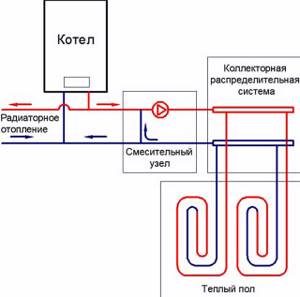
There are at least two reasons for this. The first is that it is almost impossible to control the consumption of thermal energy for a specific person. The second is an increase in the load on heating boilers, which is why they simply cannot cope with their task.
Installing an individual boiler in an apartment is possible, but it is very expensive, and sometimes it is very difficult to obtain permission for this.
Mats for warm water floors
There is a whole range of mats for warm water floors, they all have different characteristics and are in different price categories. Let's look at their main types:
On the price tag in the store, in addition to this name, you can see “Foil backing for heated floors” or “penofol with reflective coating.”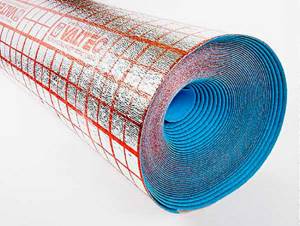
Foil mats
From the name it’s easy to guess that their main working element is a reflective surface.

Although this type of mat is cheap, it is far from the best option; it is not suitable for basement floors, but it will be a good solution when it is important to save 3–4 centimeters of living space.
Foil mats for warm water floors are laid on the base with the reflective surface facing up. The installation of pipes takes place directly on top of such a substrate. After installation, you can immediately screed.
- Film mats

Film mats for heated floors are a more advanced solution than foil mats; their thermal insulation properties are an order of magnitude higher due to the use of more modern polymers than penofol. The design features allow them to be used as a substrate for heated floors under laminate. In addition, the installation of underfloor heating pipes will be simplified by the presence of special markings and a system of fastenings (lamellas) for the pipes. The screed can also be laid on top of film mats for warm water floors without the use of intermediate layers. - Flat polystyrene foam mats
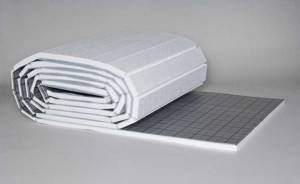
They are also foam mats, they have a high class of sound insulation, but have a number of disadvantages, which include low resistance to damage and chemical sensitivity to the composition of the screed. Due to the low chemical resistance of polystyrene foam underfloor heating, it is necessary to lay a second layer of high-density polyethylene film before laying pipes. - Special mats with bosses.
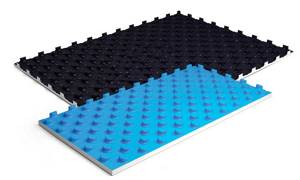
The price of underfloor heating with bosses is higher than that of polystyrene foam mats, but it justifies itself at later stages of installation.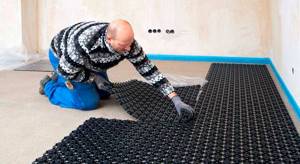
A substrate with bosses for a heated floor is one of the best solutions and has a number of advantages: rows of shaped protrusions simplify the installation of pipes - no additional pipe fixation required
- does not require additional layers before laying the screed
- accompanies the uniform distribution of heat-conducting structural elements
- has high noise, heat and waterproofing properties
Other types of substrates
cork mats and slabs made of chipboard and OSB 
In addition, when it comes to heated floors, it is better to work with such materials by specialists who have extensive experience.
Combined underlay for water heated floors
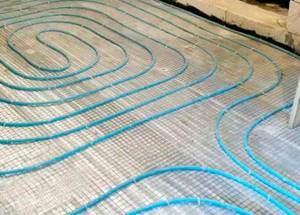
It is permissible to use 2 types of insulation at once, laid in layers, for example, the simultaneous use of foil and flat mats will give a double effect in thermal insulation, where the foil coating will have reflective properties, and polystyrene foam will have thermal insulating properties.
This type of combination is not the only one; combinations of mats with bosses, metal profiles and gypsum fiber sheets are increasingly being used.
Perhaps the only disadvantages of such a “layer cake” system will be the high cost and a significant reduction in the height of the room (not suitable for rooms with low ceilings).
Laying technology
The technology for laying the substrate is simple and can be done independently. When installing a lining intended for heated floors, it is necessary to select its thickness depending on the type of system and the conditions under which it will be used.
The reflective side of the insulation should face the direction of the heat source. There should be an air gap of 15 - 20 mm between it and the finishing floor, for the circulation of air masses and the condensation process.
The main thing is to follow the established rules:
- Carrying out a calculation - determining the amount of material; it is better if the insulating layer has a minimum of seams.
- Preparing the base - it must be level, each difference will appear on the surface over time.
- Laying a waterproofing layer - it can be cork, chipboard, etc. Before this, you need to lay dense polyethylene, it will serve as a water barrier.
- Installation of the substrate (roll or sheet) - it is laid without tension, with the obligatory approach to the walls. The material must fit closely to vertical surfaces that are covered with damper tape.
- Connection - roll-type canvases (laid in an overlap) or mats (positioned in a joint) are combined using adhesive tape.
After this, you can begin installing the heating system. If a water- or electric-type heated floor is being laid, and a foam backing with bosses or a wooden backing with grooves is used, it is enough to place the pipe or cable in the grooves.
If the substrate is smooth, additional fixation will be required. Then you need to fill the screed, although there are ways to install heated floors without it. After which, you can begin the finishing coat.

Laying an infrared mat floor is an easier option. The rolled material is simply rolled out onto a flat surface and secured with tape. A concrete screed is not required here; it is enough to put a plastic film on top and install the flooring.
To summarize, we can say that the substrate is a structural layer that cannot be avoided when installing any heated floor. You should not save on this material, as repairing the system will cost much more.
Properly installed hydro- and thermal insulation will provide heating of the room and reduce energy consumption costs.
Installation
- Measurements Installation of the underlay for a heated water floor should begin with measurements of the room in which heated floors need to be installed. When taking measurements, it is important to take into account that film and foil mats are sold in rolls, while all others are mainly sold in slabs. At the measurement stage, your task will be to minimize the length of the joints and, based on this task, you need to select the width of the rolls or the width and length of the mats for the underfloor heating.
At the next stage, the floors need to be cleaned of debris and uneven surfaces. This will allow the substrate material to be distributed more evenly in the next step.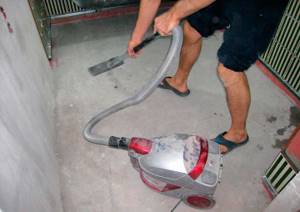
Preparing the load-bearing surface- Laying the material The substrate material must lie freely and without tension.
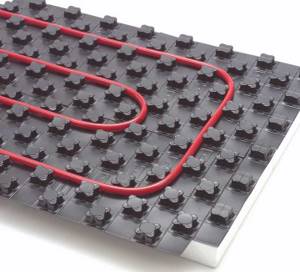
To prevent roll materials from creasing, it is better to use a long, but not heavy load, such as a block.
- Gluing The joints of the substrate should be glued before laying pipes and screeds; aluminum tape, or its cheaper analogue - metallized tape, is best suited for this purpose.
What does saving on insulation lead to?
For example, let's take a room with an area of 50 square meters.
Usually they use polystyrene foam with bosses, the cost is 1 sq. meter on average 600 rubles, thickness - 2 cm. In most cases, this thickness is not enough for insulation, with the exception of the southern regions. Additional insulation up to 4 cm will cost another 150 rubles per square meter. The total amount will be 7,500 rubles. Saving this amount is what we are talking about when choosing insulation. The owner of the house strives to cut costs and often chooses the cheapest option - underlayment for heated floors, instead of the insulation itself. Ultimately, the thrifty home owner heats the outdoors and spends even more money to maintain a comfortable indoor temperature.
Calculation of the cost of water heated floors
We have two rooms in front of us:
- the first with normal, high-quality insulation of the required thickness;
- the second - with a substrate for a warm floor under insulation and a “thrifty” owner.
| Characteristic | House No. 1 | House No. 2 |
| Floor area | 50 | 50 |
| Pipe temperature | 40 | 40 |
| Pipe diameter | 16 | 16 |
| Insulation | 60 | 20 |
| Heat flow upward | 73,76 | 65,81 |
| Heat flow down | 18,88 | 58,72 |
| Maximum floor temperature | 26,82 | 26,18 |
In the first house, with 4 cm of insulation, the heat flow into the room exceeds the heat flow down three times. All the heat that the owner of the house pays for is used to heat the room, not the street! In the house of a “frugal” owner, the heat flow upward (to the room that needs to be heated) is almost equal to the heat flow downward (to the street, to nowhere). Forty watts per square meter go down the drain.
- On 1 square meter with underfloor heating we lose 40 W, on 50 square meters - 2000 W.
- 1 cubic meter of natural gas provides 10 kW of thermal power and costs 4.5 rubles (the price depends on the region, from 4 to 8 rubles).
- 10 00 W/2000 W = 5 hours – this is how much 1 cubic meter of natural gas is enough for heat loss.
- The boiler operates on average 12 hours a day. 12/5=2.4 cubic meters of gas are spent per day on heating the street.
- 2.4 (cubic meters) x 4.5 (rubles) x 30 (days) x 7 (months of the heating period) = 2,268 rubles per year.
They paid 7,500 rubles for the insulation / 2,268 rubles = 3.3 years - the payback period for the insulation. When using underfloor heating, heat losses will increase! These materials are not insulation!
DO NOT USE UNDERWARMING FLOOR INSTEAD OF INSULATION!
When using insulation materials with insufficient thickness for complete thermal insulation or when using foil insulation, isoline (they are also a substrate for a heated floor), the owner of the house loses a lot of heat in the lower direction. This is either unreasonable savings or a serious misconception of the homeowner. Heat losses in this case are comparable to the heat flow entering the room. The use of high-quality insulation of the required thickness pays off in an average of 3-3.5 years of operation of a heated floor, when using natural gas as an energy source. Natural gas is the cheapest source of energy. If we talk about other sources, then insulation can pay for itself in 1 heating period (i.e. in 7 months).
conclusions
- Installation of warm water floors must begin with an assessment of the situation and measurements. It is necessary to decide whether the heated floor will be the main or additional type of heating of the room.
- The choice of the best underfloor heating must be approached responsibly and based on the characteristics of the room, taking into account not only the area of the room and the expected temperature, but also the humidity and height of the ceilings.

- It is much safer to use those materials that are specifically designed for warm water floors. This approach will not only save time, but will increase service life and save up to 20% on energy spent on heating the room.
It is better to purchase a substrate for a warm water floor in specialized stores, which will protect you from purchasing low-quality products.
Rules for laying foil backing
Foil underfloor heating can be in rolls, mats or slabs. When laying, this coating must be joined both in length and width. In order for the connections to have the same properties, the fragments are glued together with special metallized (foil) tape. You must glue carefully, avoiding gaps, try to make the fit as precise as possible, without gaps.
When laying thin rolled foil material in a screed, the strips may overlap one another. The size of this “overlap” is at least 10 cm. This joint is glued twice on one side and on the other. We make cross connections according to the same rules.
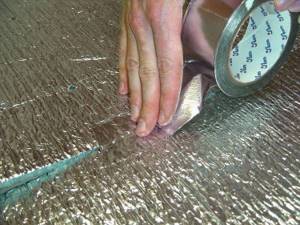
It is recommended to use foil tape for connection.
When laying mats or slabs, they are joined close to one another, then glued with the same shiny tape. Some manufacturers make a lock along the edges of the slabs, which reduces the possibility of heat leakage through the joints. Despite this, we also glue the locking joints with tape. This makes it much more reliable.
How to choose the right substrate
Before you begin installing the heating system, you should decide which underfloor heating substrate will best perform certain functions. Do not forget that each manufacturer tries to sell as many of its products as possible, and often the advertised product does not meet the qualities that were declared.
There are a number of factors that determine a high-quality substrate, and this is what you should proceed from when choosing it:
Thermal conductivity of the material
. The best substrate is considered to be the one with the lowest values, and they are determined by the thickness of the product and the material used. At the moment, there are substrates with improved energy conservation properties; they have a foil coating.
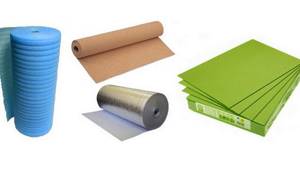
Energy saving occurs due to the reflection of infrared radiation - as a rule, this figure is 20-30%. All materials used in the manufacture of substrates meet the required construction standards for residential premises.
Strength characteristics – resistance to constant and dynamic loads
. There are materials that are compressed due to prolonged constant loads. Because of this, thermal conductivity increases. This effect should be avoided by selecting the correct load so that the mechanical impact over the entire surface is as uniform as possible.
Manufacturability
. Laying the material will be cheaper the easier it is to work with. This characteristic varies quite widely for many materials. It is best to give preference to polystyrene foam. It is very technologically advanced, the lining under a warm floor made from it is often thin, no more than 5 mm, and it is easy to cut with simple scissors.
The underfloor heating pad made of polystyrene foam is flexible, its edges are easy to connect to the walls. This material is easy to measure, cut off parts, make adjustments, and you can simply bend it near the walls. In this case, it is much easier than installing chipboard or OSB.
Additional qualities
. To simplify installation work even more, some manufacturers draw a grid on the front side or leave special bosses that protrude.

This modification greatly simplifies the installation of pipes, making it possible to secure them during the installation of the lining. The result is faster repair work, improved efficiency and longer service life of the heating system. The coolant can be installed at an equal distance, so that overheating in individual zones is excluded, that is, the entire floor is heated evenly.
Price
. This parameter is quite significant. If you have special technical knowledge, you can install heating in such a way as to obtain high heat saving rates, and also significantly save the finances necessary for the purchase of materials.
Environmental friendliness of the material
. Although any of the materials tends to emit toxic fumes, their quantity and intensity are not always the same. Due to the fact that the substrate for underfloor heating pipes will be used in conditions of elevated temperatures, it is worth paying special attention to indicators of environmental safety and harm to human health.
When looking at advertising brochures from various manufacturers about certain lining materials, not everything needs to be taken on faith, and some characteristics may not be paid attention to at all.
Noise-absorbing effect.
Any person who remembers at least something from physics lessons knows that sound is transmitted through air. Since absolutely any insulating material does not allow air to pass through, therefore, the same thing happens with sounds.
UV resistance
. Since the substrate under a heated electric floor, as well as under a water-heated one, is not directly exposed to ultraviolet radiation, this characteristic of the material does not in any way affect its performance. Perhaps it is necessary to isolate the source of X-rays, but this is unlikely to be found in a residential area.
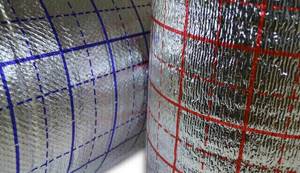
Waterproofing properties
. Let us say right away that the presence of moisture under heated floors, both water and electric, must be eliminated during the heating installation process. If a leak suddenly occurs in heating water pipes, the faster it is repaired, the less expenses the owner will have, and the materials will not be exposed to prolonged exposure to moisture. But in the case of an electric heated floor, the presence of moisture is, in principle, excluded, otherwise short circuits are possible. Therefore, how well the substrate resists moisture does not matter.
Price factor
. In most cases, the cost of the material includes the costs of advertising and product promotion. That is, when buying a product from a well-known company, you significantly overpay for the brand. However, there are many types of quality products on the market at more affordable prices, just not as advertised. A competitive price allows new firms to promote their products on the market, attract the interest of buyers and earn a business reputation.
Thus, all of the listed indicators will help you not make a mistake when choosing a substrate for a heated floor, no matter what design, so that it lasts as long as possible, and you can save on assembly.
Step-by-step algorithm for laying a substrate under a laminate board on a heated floor
Let's consider the procedure for laying a foam polyethylene backing under a laminate board on a heated floor.
First of all, you need to clear out your workspace. To do this, you can use a regular broom or vacuum cleaner.
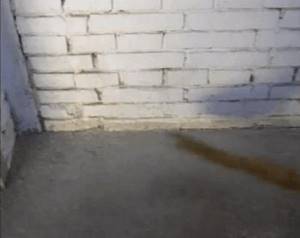
Cleaning up the workspace
Then we lay the rolled backing on the cleaned surface.
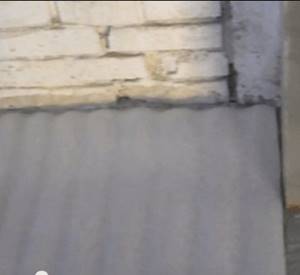
Place the roll backing on the cleaned surface
The spread substrate can be secured with double-sided tape, after which you can proceed directly to laying the laminate boards.

We fix the substrate and proceed to laying the laminate
Substrate functions
As already mentioned, the substrate ensures that heat is redirected exclusively upward. Only its use increases the efficiency of using the heating circuit several times, which affects the dynamics of heating the room. The substrate is a multilayer structure in which the following functional layers are distinguished:
- steam and waterproofing;
- insulation;
- foil layer.
There is practically no difference for what construction this part of the multi-layer cake will be used: for water or electric floors. But recently, the electric floor heating system already includes layers of heat-insulating material. But the water floor has to be installed in layers.
So, the practical qualities expected from the substrate:
- Excellent thermal and waterproofing characteristics;
- Ability to reflect heat rays;
- Ability to withstand significant thermal changes when in contact with heating elements;
- No condensation;
- Noise isolation.
An additional point in the list of properties of materials for the substrate should be its environmental safety.
Equally important is the plasticity of the material, which ensures ease of installation. In this case, it is desirable that all substrates are environmentally safe and resistant to deformation.
It is important! There is an opinion that a substrate is not needed if the top covering of the heated floor is ceramic tiles.
However, based on the economics of the system, it is better to use a substrate before laying the pipes.
Water heated floor
Works on water heating pipes laid between the ceiling and the flooring. Water is heated in a boiler or boiler and supplied through the heating circuit using a pump.
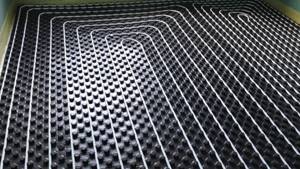
The cooled water goes back into the boiler and so on in a closed cycle. The built-in heat control system will not allow the floor to heat up above the set temperature.

This type of heated floor is good for individual housing, but is completely unsuitable for an apartment building with central heating. Another disadvantage is that if a pipe breaks or leaks, it is often necessary to dismantle the entire structure.
We recommend: Which plasticizer to choose for underfloor heating?
Features of installing a substrate under a laminate board on a warm floor
One of the most sensitive finishing flooring materials is laminated board. It is made of wood, and, as a result, it has all the characteristics of a wooden board, which has both its advantages and disadvantages. When laying laminate flooring on a heated floor, the use of an underlay is a prerequisite.
In addition to preventing heat damage to the laminate flooring, the laminate underlay also serves as a sound insulator, preventing the finished flooring from being too loud. The minimum thickness of the laminate floor board substrate on a heated floor must be at least 3 millimeters. During operation, such a substrate becomes somewhat compacted without losing its insulating properties.
Lining for infrared floor heating

The main task performed by the substrate for an infrared heated floor is to direct the infrared radiation of the film heater into the room.
Warm infrared floors and heat-reflecting substrates are offered for sale in one set.
Technology for laying IR film floor heating systems with a substrate
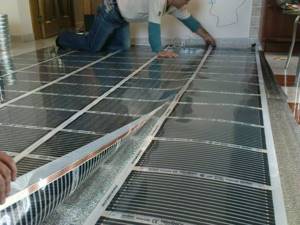
The appearance of infrared film heated floors on the market has made a small revolution in the improvement of heating systems for the bases of premises.
IR floors are attractive due to their ease of installation, the absence of wet processes and labor-intensive work on filling floors with installed heaters.
IR floors are laid in the following sequence:
- Polymer insulation is laid on a clean floor base.
- A polyethylene vapor barrier is laid on the surface of the insulation, placing its edges on the walls around the perimeter of the room.
- Rolls of IR heating film are rolled out.
- The film is cut according to special marks.
- The cut parts of the film are connected to each other in parallel.
- A thermal sensor is placed under the film. The temperature sensor is connected to the thermostat.
- IR floors are laid at a distance of 100 mm from the walls.
- Areas of the floor intended for the location of stationary furniture are not covered with film.
- A polymer-based foil bedding is placed on the film.
- The entire surface is covered with a soft polymer backing for installation of the floor covering. To learn how to properly lay out infrared film, watch this video:
The underlay for underfloor heating film is compatible with many types of floor coverings, except those laid on adhesive and cement bases.
Electric heated floor
It is also a multilayer structure, where the heat transfer element is a flexible electrical cable or heating rod mats operating from the electrical network. This type of heated floor is not prohibited from being installed in an apartment building.
Unlike a water floor, this floor is not subject to leakage, and if any element breaks, it is enough to dismantle only one section above it.
Electric heated floors, in turn, are divided into:
- cable (heating occurs using a flexible cable located between the floor slab and the floor covering);
- rod-type (heated using a carbon rod);
- infrared, also known as film (there are several types of heating, such as film with carbon stripes);
- heating mats (combination of cable with mesh backing).
Regardless of what type of floor has been chosen, an important component is the underlay for heated floors - a heat-insulating material.
Characteristics of expanded polystyrene
Foamed polystyrene foam looks more advantageous compared to other thermal insulation materials, due to the fact that it allows you to get a fairly dense, durable and rigid base. During its production, the initial mass is foamed by introducing a low-boiling liquid into it, under the influence of which granules are formed that have a waterproof styrene shell. After exposure to hot steam, granules are obtained that have increased in size by 10 to 30 times compared to the original size. After the granules are sintered together, strong, rigid slabs are formed.

Laying pipes on a grid
Extruded polystyrene foam with low thermal conductivity is very popular. The positive qualities of this material include the following:
- Moisture resistance and the ability to not allow steam to pass through ensure that the thermal conductivity of the insulation remains at the same level even when exposed to moisture.
- Environmental friendliness and safety of the material for humans and the environment.
- Biological passivity and the ability of the material to prevent the formation of fungus and mold.
- Resistance of the material to chemical reagents.
- Maintains performance at extremely low (down to –50 degrees) and high (+85 degrees) temperatures.
- The low weight of polystyrene foam boards allows them to be used on any floor without adding weight to their structure.
- The material is easy to process, trim and lay. All work can be done independently, without involving assistants.
- Thanks to its smooth surface, the material interacts well with the base on which it is laid.
- Excellent thermal insulation properties are provided by the bubble structure of the material.
- Expanded polystyrene simultaneously creates a waterproofing layer due to its resistance to moisture.
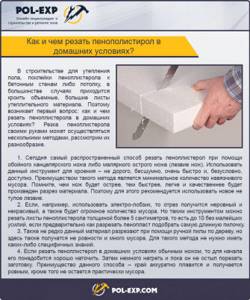
How and with what to cut polystyrene foam at home?

Laying pipes on a foil layer with markings
An important quality for flooring is its noiselessness. Expanded polystyrene boards have excellent sound insulation properties.

The thickness of the heated floor structure taking into account the pouring of the concrete screed
The safety of the material is no less important - polystyrene foam practically does not burn and even has a self-extinguishing property. However, during the smoldering process it releases harmful toxins.
Types of substrates
The underfloor heating is a flexible flooring that is located between the floor slab and the heating element. The substrate has a number of functions:
- waterproofing - protects the heating element from moisture penetrating from below;
- thermal insulation - prevents heat penetration downwards;
- distributes heat evenly if the heating elements are located at some distance from each other. Thanks to the substrate, heat is distributed evenly over the entire surface;
- removes heat from heating elements, preventing overheating;
- performs a small soundproofing function;
- evens out minor unevenness in the subfloor.
Since the substrate has several purposes, it must meet certain requirements:
- be moisture resistant, that is, not fail if water gets on it;
- be elastic and withstand the pressure of the coating and the weight of the contents of the room;
- be tough and not crumble under pressure;
- be resistant to fungal mold and bacteria.
We recommend: How to install heated flooring under laminate on a concrete floor?
Substrates are:
- mineral;
- natural;
- synthetic;
Mineral types of substrate include fiberglass. It is a rolled material made of fiberglass. Fiberglass does not get wet, does not burn, but has minimal thermal insulation. Used as a contour between the water-heated floor and the coating.
Natural types include cork, jute, and felt substrates. These are easy to use, environmentally friendly materials.

Without special impregnation, they are quickly exposed to destructive biological influences, that is, they become infected with fungus and bacteria, which significantly reduces their service life.
The above types of materials are used as a substrate between the screed and the floor covering, for example, under laminate.
